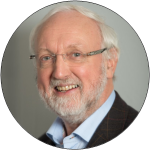

FIG Article of the Month - January 2022 |
In this final "Video of the Month" series Ms. Pauline de Wilde talks with Frank Tierollf, Sisi Zlatanova, Noud Hooyman, Henk Scholten and Jan Bruijn about the concept ‘’Digital Twins’’. ”How can Digital Twin support to increase legal certainty?” and, is there a role for FIG to play? The Triple Helix model of innovation between Government, Business and University helps making policy. Together they discussed their roles, interactions and solutions.
The concept ‘’Digital Twins’’ is regularly mentioned nowadays. Without a common understanding the discussion could be focussed on digital twinning as a goal instead as a mechanism for solving environmental and social challenges like climate adaptation or energy transition. For years we have basic registrations for land registry, topography, cables and pipelines, spatial plans, addresses and buildings and alike. In the Netherlands we are working on semantic coherence and are increasingly moving from 2D to 3D. So it is not something completely new; however we should embrace it because it supports bringing different sources and knowledge from different communities together. Aiming at an integrated coherent approach to various challenges in society.
With an accurate digital representation of reality, challenges in society can be approached with an integral perspective. Working towards a basic reference digital twin; that can be further expanded in various thematic domains. Previously the physical world was approached with models; now we can calculate and anticipate to situations better with a digital twin. This enables a better contribution to solution making: integrated, faster and therefore more sustainable.
A digital twin has many stakeholders in the different domains, so
partnerships are needed to bring it to full bloom. Digital twins
requires an open way of working, which also includes public-private
partnerships. Public policies can help leveraging true potential of
digital twin technology by ensuring preconditions such as development
and management of the basic reference Digital Twin; a foundation on
which others can further build their thematic digital twins. By using
the same basis and building on this, an integral approach is created.
As organisation we focused on the perspective to move towards a
data-centric approach. Fitting in the digital twin philosophy. As
geo-information community we can support each other by sharing our
journeys.
 |
Frank Tierollf, Chair Executive Board KadasterFrank is Chairman of the Executive Board of the Netherlands’
Cadastre, Land Registry and Mapping Agency, in short: Kadaster.
His focus is to position and represent Kadaster at national and
international level. Main areas of responsibility are Strategy
and Policy, Finance and Governance, Human Resources and Facility
Management. He is a promoter of Kadaster as a partner in the GEO
sector and emphasizes the relevance of innovation. Frank is a
strong ambassador of partnerships between the academic, private
and public sector. |
 |
Sisi Zlatanova, Professor, Head of GRID, Faculty of Built Enviroment, UNSW SydneySisi Zlatanova is a professor and head of GRID at the Faculty of Built Environment, UNSW Sydney. Sisi has been conducting research in many aspects of 3D geoinformation: data representation, structuring, analysis and BIM/GIS integration. Her recent research concentrates on 3D Indoor modelling and navigation. She is author and co-author of more than 400 papers and 23 books. She has been involved in the work of several internationa organisations. She is the president of ISPRS TC IV on Spatial Information science, the treasurer of UDMS and a co-chair of OGC SWG IndoorGML. |
 |
Noud Hooyman, Chief Geo-information Officer Directorate for Spatial Planning Ministry of the Interior and Kingdom Relations NetherlandsNoud Hooyman studied applied mathematics and information
technology at the Technical University of Delft, the
Netherlands. Until recently he was head of the department for
geo information within the Ministry of the Interior and Kingdom
Relations (Home office), which is the coordinating Ministry in
the field of geo information in The Netherlands. At the moment
he is the chief geo-information officer and therefore
responsible for the development of geo-information policies in
The Netherlands. |
 |
Henk Scholten, Director Research and Innovations Geodan NetherlandsProfessor dr. H.J. Scholten is co-founder and Director
Research and Innovations at Geodan, one of the largest European
companies specialised in Geospatial Information Technology.
Professor dr. H.J. Scholten has studied Mathematics and Geography at the Vrije Universiteit Amsterdam and obtained his Ph.D. on the subject of models for housing allocation at the Faculty of Geography of the University of Utrecht in 1988. He has edited or authored numerous books on different aspects of GIScience and published over 100 book chapters, journal papers and other publications. He has supervised 15 PhD dissertations and numerous MSc theses. In his role as director of Geodan, professor Scholten has been supervisor on a large number of national and international GIS projects and has been advisor for several ministries in different countries. Since 2017 professor Scholten is Lead Scientist at the Joint Research Centre (JRC) to develop novel CAS (Centre for Advanced Studies) projects on Digital Transformation – Machine Intelligence and Human Behaviour. In this function, he establishes project plans contributing to high profile scientific results. He was honoured in 2016 with the Lifetime Achievement Award by Geospatial Media and Communications for his contribution to the overall development of GIS/geospatial community worldwide. In 2015, he received the title of honorary Doctor of Science from the Manchester Metropolitan University for his extensive contributions to GIS. Professor Scholten received in 2009 the ‘Lifetime Achievement Award’ by Jack Dangermond, founder of ESRI. This award is given to a person who has contributed significantly to advancing the science and technology of GIS throughout his career. In 2005, professor Scholten received a Royal Decoration for his significant contribution to geo-information, both on a national and international level. |
 |
Jan Bruijn, Condultant at GeonovumJan Bruijn is director at SVB-BGT, the foundation of source-holders of the Key Register of Large Scale Topografy. In the past eight years he led the transition of 400 sourceholders to build and maintain this Key Register in collaboration with geobusiness. By this year Jan founded Nest4Innovation to bring knowledge and people together to work on innovative concepts and build partnerships and teams to make innovation happen and create business value. Last Year he worked at Geonovum with a team on the proposal for a National Infrastructure of Digital Twins in collaboration with the triple helix. Jan Bruijn studied information technology at the Technical University of Twente and obtained a Master in Business Administration at the Twente School of Management. |